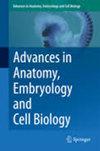胰腺导管的发育及其对器官形成的贡献
4区 生物学
Q3 Medicine
Advances in Anatomy Embryology and Cell Biology
Pub Date : 2024-01-01
DOI:10.1007/978-3-031-62232-8_2
引用次数: 0
摘要
胰腺是一个具有双重功能的器官,外分泌细胞帮助消化,内分泌细胞调节葡萄糖平衡。这些细胞类型共享共同的祖细胞,并从胚胎导管中产生。胚胎导管中的早期信号事件塑造了新生儿、青春期和成年期的外分泌和内分泌胰腺。本章将讨论用于研究导管的工具的最新进展,以及我们目前对导管发育如何促进胰腺器官发生的理解。本文章由计算机程序翻译,如有差异,请以英文原文为准。
Development of the Pancreatic Ducts and Their Contribution to Organogenesis.
The pancreas is a dual-function organ, with exocrine cells that aid in digestion and endocrine cells that regulate glucose homeostasis. These cell types share common progenitors and arise from the embryonic ducts. Early signaling events in the embryonic ducts shape the neonatal, adolescent, and adult exocrine and endocrine pancreas. This chapter discusses recent advances in the tools used to study the ducts and our current understanding of how ductal development contributes to pancreatic organogenesis.
求助全文
通过发布文献求助,成功后即可免费获取论文全文。
去求助
来源期刊
CiteScore
2.00
自引率
0.00%
发文量
0
期刊介绍:
"Advances in Anatomy, Embryology and Cell Biology" presents critical reviews on all topical fields of normal and experimental anatomy including cell biology. The multi-perspective presentation of morphological aspects of basic biological phenomen in the human constitutes the main focus of the series. The contributions re-evaluate the latest findings and show ways for further research.

 求助内容:
求助内容: 应助结果提醒方式:
应助结果提醒方式:


